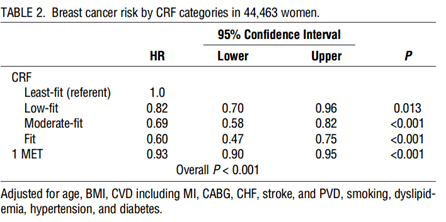Scientific evidence collected for seven decades strongly supports the position that higher cardiorespiratory fitness (CRF) levels are associated with more favorable health outcomes, including mortality due to various cancers. Findings from several small population studies suggest that a physically active lifestyle offers protection against pre- and postmenopausal breast cancer. However, physical activity in these studies was self-reported and subject to inaccuracies. CRF can be assessed objectively and accurately via a standardized exercise treadmill test (ETT), the peak exercise capacity achieved during said ETT being expressed in peak metabolic equivalents (METs; 1 MET ≈ 3.5 mL·kg−1 of body weight per minute). However, no studies have yet examined the association between breast cancer and CRF assessed objectively by a standardized ETT in a large population.
In our study, published in the June 2024 issue of Medicine & Science in Sports & Exercise®, we evaluated the association between CRF and breast cancer in 44,463 women (mean age ± SD; 55.1 ± 8.9 yr). All women were cancer free before completing the ETT and had no evidence of heart disease. We formed CRF categories (Least-fit, Low-fit, Moderate-fit and Fit) based on age and peak METs achieved during the ETT and assessed the incidence of breast cancer over several decades.

After more than 20 years of follow-up and 438,613 person-years of observation, 994 women developed breast cancer. After controlling for covariates such as body mass index (BMI) and comorbidities (i.e., cardiovascular disease, dyslipidemia, hypertension and diabetes) the risk of breast cancer was inversely related to exercise capacity. For each 1-MET increase in CRF, the risk of developing cancer was approximately 7% lower. When risk was assessed across CRF categories with the Least-fit group as the reference group, the risk of breast cancer was 18% lower for Low-fit women, 31% for Moderate-fit, and 40% for Fit (see table).
Our findings support the idea that higher CRF levels lower the risk of developing breast cancer in women independent of other established risk factors. This is the largest study to examine the relationship between CRF assessed objectively by a standardized ETT and the risk of developing breast cancer.
Most middle-aged and older women can achieve improved CRF levels by engaging in moderate-intensity physical activities for at least 150 minutes per week. We strongly advise that regular moderate-intensity activity should be part of a healthy lifestyle approach and should become part of routine health care counseling in women for primary breast cancer prevention.

Peter Kokkinos, PhD, FACSM, is a professor in the Department of Kinesiology and Health at Rutgers University in New Brunswick, New Jersey. Dr. Kokkinos completed his graduate work in exercise physiology at the University of Maryland and postdoctoral training at the Veterans Affairs Medical Center in Washington, D.C. His research is focused on the prognostic, preventive and therapeutic aspects of cardiorespiratory fitness, physical activity and exercise.




